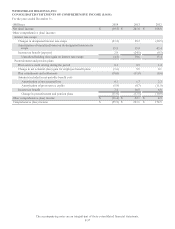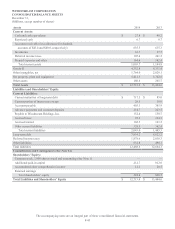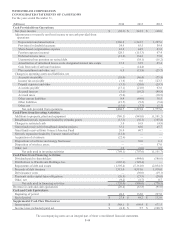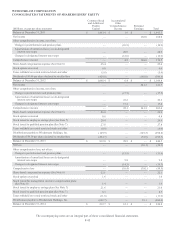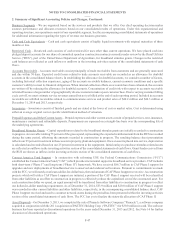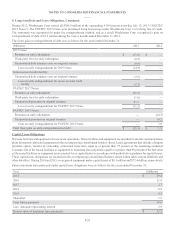Windstream 2014 Annual Report Download - page 163
Download and view the complete annual report
Please find page 163 of the 2014 Windstream annual report below. You can navigate through the pages in the report by either clicking on the pages listed below, or by using the keyword search tool below to find specific information within the annual report.
NOTES TO CONSOLIDATED FINANCIAL STATEMENTS
____
F-47
2. Summary of Significant Accounting Policies and Changes, Continued:
Business Segments – We are organized based on the services and products that we offer. Our chief operating decision maker
assesses performance and allocates resources based on our consolidated results of operations. Under this organizational and
reporting structure, our operations consist of one reportable segment. See the accompanying consolidated statements of operations
for additional information regarding the types of revenue our business generates.
Cash and Cash Equivalents – Cash and cash equivalents consist of highly liquid investments with original maturities of three
months or less.
Restricted Cash – Restricted cash consists of cash restricted for uses other than current operations. We have placed cash into
pledged deposit accounts for our share of committed spend on construction contracts currently under review by the Rural Utilities
Service (“RUS”), part of the United States Department of Agriculture, for broadband stimulus grants. Changes in the restricted
cash balances are reflected as cash inflows or outflows in the investing activities section of the consolidated statements of cash
flows.
Accounts Receivable – Accounts receivable consist principally of trade receivables from customers and are generally unsecured
and due within 30 days. Expected credit losses related to trade accounts receivable are recorded as an allowance for doubtful
accounts in the consolidated balance sheets. In establishing the allowance for doubtful accounts, we consider a number of factors,
including historical collection experience, aging of the accounts receivable balances, current economic conditions and a specific
customer’s ability to meet its financial obligations. When internal collection efforts on accounts have been exhausted, the accounts
are written off by reducing the allowance for doubtful accounts. Concentration of credit risk with respect to accounts receivable
is limited because a large number of geographically diverse customers make up our customer base. Due to varying customer billing
cycle cut-off, we must estimate service revenues earned but not yet billed at the end of each reporting period. Included in accounts
receivable are unbilled receivables related to communications services and product sales of $40.2 million and $46.3 million at
December 31, 2014 and 2013, respectively.
Inventories – Inventories consist of finished goods and are stated at the lower of cost or market value. Cost is determined using
either an average original cost or specific identification method of valuation.
Prepaid Expenses and Other Current Assets – Prepaid expenses and other current assets consist of prepaid services, rent, insurance,
maintenance contracts and refundable deposits. Prepayments are expensed on a straight-line basis over the corresponding life of
the underlying agreements.
Broadband Stimulus Grants – Capital expenditures related to the broadband stimulus grants are initially recorded to construction
in progress. A receivable totaling 75 percent of the gross spend, representing the expected reimbursement from the RUS is recorded
during the same period, offsetting the amounts recorded in construction in progress. The resulting balance sheet presentation
reflects our 25 percent investment in these assets in property, plant and equipment. Once an asset is placed into service, depreciation
is calculated and recorded based on our 25 percent investment in the equipment. Initial outlays to purchase stimulus-related assets
are reflected as outflows in the investing activities section of the consolidated statements of cash flows. Grant funds received from
the RUS are shown as inflows in the investing activities section of the consolidated statements of cash flows.
Connect America Fund Support – In conjunction with reforming USF, the Federal Communications Commission (“FCC”)
established the Connect America Fund (“CAF”) which provides incremental support to broadband service providers. CAF includes
both short-term (“Phase I”) and long-term (“Phase II”) framework. We have received $86.7 million in CAF Phase I support for
upgrades and new deployments of broadband service to unserved and underserved locations. Pursuant to commitments we made
with the FCC, we will match, on at least a dollar-for-dollar basis, the total amount of CAF Phase I support we receive. As construction
projects which will utilize CAF Phase I support are initiated, a portion of the CAF Phase I support received will be reclassified
from other liabilities as an offset to construction in progress to effectively reduce the capitalized cost of the constructed asset. For
each construction dollar we spend, an equal amount will be transferred from other liabilities to construction in progress to reflect
our dollar-for-dollar matching requirement. As of December 31, 2014, $53.9 million and $20.0 million of CAF Phase I support
was recorded in other current liabilities and other liabilities, respectively, in the accompanying consolidated balance sheet. CAF
Phase I support received and used to construct network assets during the period has been presented within the investing activities
section of the consolidated statements of cash flows. The FCC has yet to finalize the statewide allocation of CAF Phase II.
Asset Disposals – On December 5, 2013, we completed the sale of Pinnacle Software Company (“Pinnacle”), a software company
acquired in conjunction with the 2011 acquisition of PAETEC Holding Corp. (“PAETEC”) for $30.0 million in cash. The software
business has been reported as discontinued operations for the years ended December 31, 2013 and 2012. See Note 14 for further
discussion of discontinued operations.


